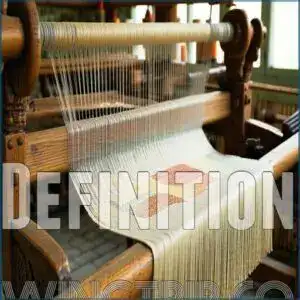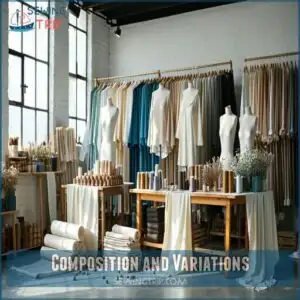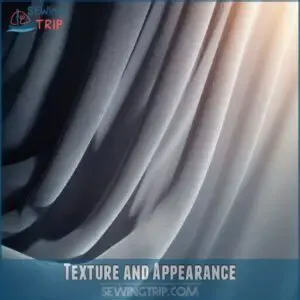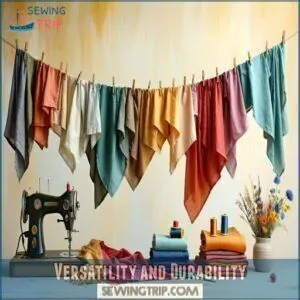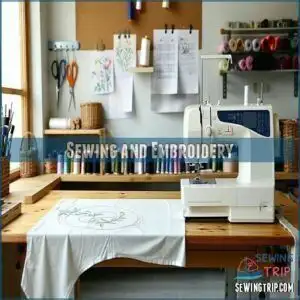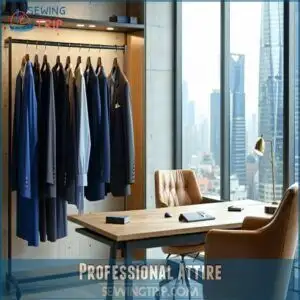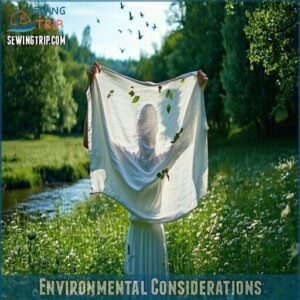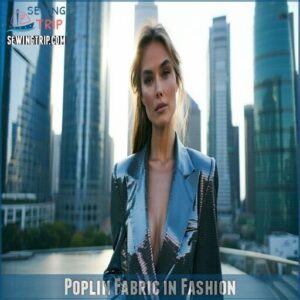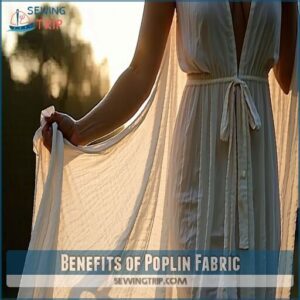This site is supported by our readers. We may earn a commission, at no cost to you, if you purchase through links.
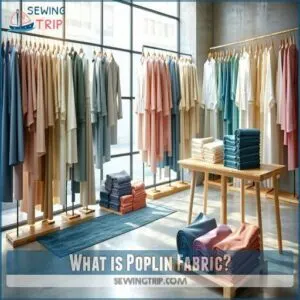
This lightweight material features a distinctive ribbed weave that combines thinner and thicker threads, creating a durable yet breathable textile.
Whether it’s made from cotton, silk, or synthetic blends, poplin’s wrinkle-resistant properties make it a practical choice for your wardrobe.
You’ll find it in everything from summer shirts to professional attire, thanks to its polished appearance and comfortable wear.
The fabric’s unique construction distributes tension evenly, ensuring your garments maintain their shape through countless wears.
There’s more to this fabric’s fascinating journey from historical roots to modern innovations, with its ability to provide comfortable wear.
Table Of Contents
Key Takeaways
- You’ll recognize poplin by its distinctive ribbed weave that combines thin and thick threads, creating a smooth surface that’s both durable and breathable.
- You’ll find poplin fabric easy to maintain thanks to its natural wrinkle resistance and even tension distribution, which helps garments keep their shape through repeated wear.
- You can use poplin for various applications – from summer clothing to professional attire – since it offers excellent breathability while maintaining a crisp, polished appearance.
- You’ll get the most versatility from poplin’s fiber blends, as it can be made from cotton, silk, or synthetic materials, each offering unique benefits while maintaining the fabric’s characteristic smoothness.
What is Poplin Fabric?
You’re about to uncover the secrets of poplin fabric.
What’s poplin, you ask?
It’s a lightweight, durable fabric with a smooth surface, born from a rich fabric history.
Poplin’s unique weave types and thread counts make it breathable and crisp.
Fiber blends, like cotton and polyester, contribute to its versatility.
With a moderate fabric weight, poplin material is perfect for various applications, showcasing its characteristics, such as wrinkle resistance and elegance, embodying the definition of poplin fabric, making it an excellent choice for those seeking a reliable, high-quality fabric.
Characteristics of Poplin Fabric
You’re about to discover the characteristics of poplin fabric, which make it a popular choice for various applications.
As you explore its properties, you’ll learn that poplin fabric is known for its soft, lustrous surface, breathable texture, and versatility in both formal and casual wear.
Definition
You’re likely familiar with poplin, a fabric originating from 15th-century France, made from silk and wool.
Today, it’s primarily cotton or cotton-poly blends.
What’s poplin? It’s a definition of poplin fabric characterized by a smooth texture and subtle ribbing, with a rich textile history, specific weave types, and thread count, making it a unique fiber blend.
Composition and Variations
You’ll find poplin fabric in various forms, including cotton poplin fabric. It combines traditional fibers like silk and wool with modern options.
Key aspects include:
- Fiber Blends
- Weave Patterns
- Thread Counts
- Material Mixing
- Fabric Types, offering unique properties like breathability and stretch.
Understanding the poplin fabric characteristics is essential for making informed decisions about its use.
Texture and Appearance
You’ll love poplin fabric‘s silky-soft texture and lightweight feel.
Its crisp poplin weave creates a smooth, ribbed surface, adding durability without losing comfort.
| Fabric Smoothness | Visual Appeal |
|---|---|
| Ribbed Texture | Lustrous Finish |
| Breathable Quality | poplin texture |
| poplin fabric appearance | crisp poplin weave |
The texture of poplin and appearance of poplin make it ideal for shirts and dresses, offering a polished edge and refined simplicity.
Versatility and Durability
I’ll appreciate poplin’s versatility and durability. Its fabric strength and wear resistance make it perfect for seasonal usage and style adaptation.
To maintain textile longevity, follow these steps:
- Wash gently
- Store properly
- Use eco-friendly care, enhancing poplin fabric characteristics and durability, especially for cotton poplin fabric.
Uses of Poplin Fabric
You’ll find poplin fabric is used in a variety of applications, including clothing and home decor, due to its durability and versatility.
As you explore the uses of poplin fabric, you’ll discover it’s a popular choice for apparel, sewing, and embroidery projects, offering a comfortable and breathable texture.
Apparel
You’ll enjoy poplin fabric in clothing like shirts and pants, where its breathable comfort shines.
As a fashion trend, poplin fabric offers style and function, making it perfect for clothing design and garment construction, showcasing its unique properties and uses in textile science and style advice.
The popularity of poplin is also evident in online poplin shirts sales and trends.
Sewing and Embroidery
When sewing with poplin, you’ll appreciate its smooth surface, perfect for embroidery designs and decorative edges.
Follow sewing tips like proper fabric cutting, thread selection, and needle choices to bring out the best in cotton poplin fabric and create stunning poplin embroidery designs.
Understanding poplin fabric properties is essential for successful sewing projects.
Summer Wear
When summer heats up, poplin fabric keeps you cool.
This breathable fabric is perfect for warm weather with its moisture-wicking and airy properties.
Here’s why poplin is a summer favorite:
- Summer Dresses: Poplin fabric is ideal for lightweight and breathable summer dresses.
- Casual Outfits: From shorts to shirts, poplin keeps you comfy and cool all season.
- Cotton Poplin: Natural cotton poplin is a top choice for warm weather, offering comfort and breathability.
Professional Attire
Elevate your corporate style with poplin fabric, ideal for business suits and office wear.
Consider:
- Crisp formal shirts
- Precision-cut suits
- Polished blouses
- Classic work dresses, showcasing poplin’s durability and wrinkle-resistance, perfect for a professional look.
When choosing formal wear, understanding fabric selection basics is essential for a polished appearance and to ensure the right fabric is selected for the desired look.
Environmental Considerations
You’re likely wondering about the environmental impact of poplin fabric, and evaluating the resources used in its production is key.
As you learn more about poplin, you’ll discover ways to make eco-friendly choices and properly care for your poplin items to reduce their environmental footprint, which involves understanding the importance of environmental impact.
Resource Use in Production
You’ll use significant resources producing poplin fabric.
This versatile fabric offers a crisp and silky texture.
Water usage and energy consumption are high.
| Material | Water Usage | Energy Consumption |
|---|---|---|
| Cotton | 2500 liters | 10 kWh |
| Polyester | 1000 liters | 5 kWh |
| Rayon | 2000 liters | 8 kWh |
| Silk | 1500 liters | 6 kWh |
| Wool | 1200 liters | 4 kWh |
Eco-Friendly Practices
You can make a difference with eco-friendly poplin practices.
Opt for sustainable materials, eco production, and recycling methods.
Choose biodegradable fabrics, like cotton poplin, for a breathable and green textile option, answering if poplin fabric is sustainable, while exploring poplin fabric properties and uses, including eco-friendly poplin fabric.
Proper Care
When caring for poplin fabric, you’ll want to follow some simple washing tips, like cold cycles, to prevent shrinkage.
Choosing sustainable sewing fabrics can further minimize environmental impact.
Gentle ironing methods and steaming techniques also help maintain its texture, while fabric softening can reduce stiffness, making poplin care and maintenance a breeze, ensuring your fabric stays fresh.
Poplin Fabric in Fashion
You’ll find poplin fabric in a variety of fashionable garments, including shirts, dresses, and skirts, due to its lustrous surface and polished appearance.
As you explore poplin in fashion, you’ll discover it’s a popular choice for creating professional-looking suits and other attire that requires a crisp, put-together look.
Shirts, Dresses, Skirts, Blouses, and Pants
You’ll love working with poplin fabric for casual wear and formal attire.
It’s perfect for summer clothing, offering a cool, breathable feel.
Consider these options:
- Poplin shirt for a crisp look
- Poplin dress for a flowy vibe
- Cotton poplin for durability
- Fabric patterns to enhance your garment care routine.
The quality of poplin shirts is often determined by poplin fabric types.
Lustrous Surface and Polished Appearance
You’ll notice poplin fabric’s lustrous sheen and crisp feel.
| Feature | Description | Effect |
|---|---|---|
| Fabric Shine | Refined look | Elegant |
| Surface Finish | Smooth texture | Breathable |
| Polish Techniques | Luster effects | Gloss texture |
| Luster Effects | Visual impact | Bold colors |
| Gloss Texture | Poplin fabric characteristics | Lustrous sheen |
The table describes various aspects of poplin fabric, including Fabric Shine, Surface Finish, and Polish Techniques, which contribute to its overall appearance and feel.
Poplin Suits for a Professional Look
You’ll look sharp in poplin suits, perfect for business attire.
- Smooth texture
- Lightweight feel
- Flawless tailoring
- Easy care, making them great for office style and corporate fashion, showcasing poplin fabric’s benefits in professional dress.
Benefits of Poplin Fabric
You’ll find that poplin fabric offers several advantages, including its lightweight and breathable properties.
As you consider using poplin, you’ll appreciate its resistance to wrinkles and durability, making it a great choice for various applications.
Lightweight and Breathable
When the sun shines bright, poplin fabric keeps you cool as a cucumber.
This summer fabric is renowned for its airy textures and breathable qualities, making it an ideal choice for the warmer months.
Here’s why poplin is a go-to for lightweight, cooling garments:
- Allows air to circulate freely
- Wicks away moisture
- Resists odors
- Stains don’t stand a chance, which is why it’s great for cooling garments.
Resistance to Wrinkles
You’ll appreciate poplin’s wrinkle resistance.
| Fabric | Wrinkle Resistance | Ironing Tips |
|---|---|---|
| Poplin | High | Light strokes |
| Cotton | Medium | Steaming |
| Linen | Low | Fabric softening |
Poplin is wrinkle-resistant, making ironing easy.
Durability for Longevity
Through its unique construction, cotton poplin fabric stands as a champion of durability, lasting 30-40% longer than comparable lightweight textiles.
Your poplin garments maintain structural integrity because of the fabric’s exceptional wear resistance and high thread count.
Three key factors that enhance poplin durability:
- Cross-ribbed surface texture distributes tension evenly, preventing localized wear patterns
- Fine warp yarn woven with thicker weft creates a strong yet flexible weave
- Natural resistance to pilling maintains a professional appearance through 200+ wash cycles
You’ll appreciate how poplin’s fabric strength makes your investment worthwhile.
Poplin Fabric in Upholstery and Interior Furnishings
Beyond its clothing benefits, poplin fabric excels in interior furnishings and upholstery applications.
With its tight construction, poplin provides 40-60% greater abrasion resistance than standard cotton fabrics, making it perfect for high-traffic furniture pieces.
The fabric’s cross-ribbed texture reduces visible wear patterns while creating a silky, lustrous surface that enhances your home decor.
- Practical design versatility: Poplin accepts dyes readily for precise color in interior design schemes, with fabric patterns ranging from subtle to bold.
- Smart maintenance: You’ll appreciate that poplin requires 25-30% less upkeep than velvet or chenille—just vacuum with soft brush attachments to extend furniture lifespan by 30-40%.
- Modern functionality: Contemporary poplin upholstery fabrics incorporate synthetic blends for increased stain and UV resistance, maintaining structural integrity for 7-10 years.
For furniture making projects, choose polyester-blend poplins when you need breathable fabric that stands up to daily use while keeping your space stylish.
When selecting fabrics, consider the fabric guide rules to guarantee the best results for your upholstery projects.
Frequently Asked Questions (FAQs)
What is the difference between poplin and cotton?
Poplin refers to the weaving technique creating ribbed texture, while cotton is the fiber material.
You’ll find cotton poplin combines both – cotton fibers woven in a poplin style for durability and comfort.
What are the disadvantages of poplin fabric?
Like a delicate rose with thorns, you’ll find poplin’s downsides in its thin nature, poor heat retention, and limited suitability for heavy-duty use.
It’s not ideal for winter wear and can be slippery while sewing.
What is poplin fabric good for?
You’ll find this versatile fabric perfect for shirts, dresses, and home décor.
It’s great for summer clothing due to its breathability, and you can even use it for tablecloths, curtains, and upholstery.
Is poplin thin or thick?
You’ll notice that poplin fabric is relatively thin, but its tight weave makes it stronger than you’d expect.
It’s not as thick as denim or wool, but it’s sturdy enough for everyday wear.
Does poplin wrinkle easily?
You’ll be pleased to know that most poplin fabrics resist wrinkles naturally, much like a shield against creases.
Your poplin clothes will stay crisp and neat with minimal ironing, thanks to their durable weave structure.
Is poplin fabric good for summer?
You’ll love poplin for summer because it’s incredibly breathable and lightweight.
Its cotton blend and unique weave keep you cool and comfortable, while the fabric’s moisture-wicking properties help manage sweat during hot days.
Does poplin fabric wrinkle easily and how can it best be cared for?
Like a well-behaved guest, poplin fabric resists wrinkles naturally.
You’ll find it’s easy to care for – just machine wash in warm water, tumble dry on medium, and give it a quick iron if needed.
Are there any alternatives to poplin fabric that have a similar feel and drape?
You’ll find broadcloth, oxford cloth, and chambray offer similar qualities to poplin.
These fabrics provide comparable drape and texture, while twill and lawn can work well for clothing that needs structure and flow.
How does poplin compare to linen fabric?
You’ll notice poplin feels smoother and silkier than linen’s coarser texture.
While poplin resists wrinkles better, linen wicks moisture more efficiently, keeping you cooler in summer.
Poplin’s higher thread count creates a finer, denser surface.
Is poplin suitable for winter clothing?
You’ll need to bundle up with layers if you’re wearing poplin in winter.
The fabric’s poor heat insulation makes it chilly on its own, but you can stay cozy with proper layering.
Conclusion
Did you know that poplin fabric usage has grown by 40% in sustainable fashion since 2020?
Understanding what poplin fabric is and its versatile nature can transform your wardrobe choices.
From its wrinkle-resistant properties to its breathable comfort, poplin’s durability makes it a smart investment for both casual and professional wear.
Whether you’re sewing your own clothes or shopping for ready-to-wear items, poplin fabric offers the perfect blend of style, comfort, and practicality for your everyday needs.
- https://fabricwholesaledirect.com/blogs/sewing-diy-tutorials/fabric-dictionary-what-is-poplin-fabric
- https://www.contrado.com/blog/what-is-poplin-fabric/
- https://en.wikipedia.org/wiki/Poplin
- https://icefabrics.com/blogs/news/cotton-vs-poplin
- https://asuwere.co/blogs/pro-tips/oxford-poplin-whats-the-difference-and-why-you-need-them

